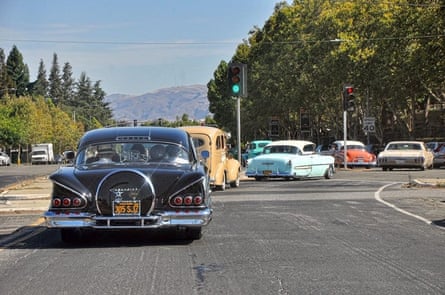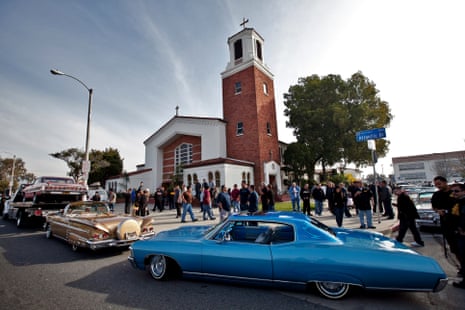After a 42-year ride, the California car magazine Lowrider is cruising its final lap.
Citing a rise in digital readership, Ten Publishing announced that it would cease to print the celebrated magazine.
What started four decades ago as a DIY car magazine became a vehicle for something larger: cultural pride, an expression of resistance and an outlet that gave a generation of Mexican Americans, or Chicanos, the chance to see themselves reflected positively in print. It also became a flashpoint where issues of policing and demonization of minorities clashed with emerging forces of Latino youth.
News of the magazine’s latest turn was met by laments and retrospectives on what it meant for Chicano culture in California and beyond.

Lowriders, often customized, vintage cars with extravagant paint jobs, take their name from their ground-hugging, slow-and-low style. The first generation of lowriders rolled out in Los Angeles, home to a booming Mexican American population and resulting racial tension that ignited the zoot suit riots of 1943.
Decades before Snoop Dogg and the 90s west coast rap scene cemented lowriders’ place in popular culture, three students from San Jose State University set out to document the nascent car scene and, along the way, offer a platform for the Bay area’s Chicano community.
Larry Gonzalez, Sonny Madrid and David Nunez pooled their money and launched Lowrider’s first edition in 1977. Those first editions included artwork drawn behind prison walls, photos from the community and of course, pictures of coveted, vintage cars.
“It had a lot of soul. It had a lot of heart,” said Gilbert Chavez, a close friend to Madrid who carried his ashes to the cemetery for “Sonny’s last cruise”.
“You saw the people, you saw the neighborhood. It wasn’t a magazine, it was a yearbook,” he said.
Chavez remembers the early editions as Lowrider’s glory years. It was a time, he says, when a person didn’t need to be a celebrity to appear in the magazine and the photographers who shot the story were inside players in the lowrider scene.
This article includes content provided by Instagram. We ask for your permission before anything is loaded, as they may be using cookies and other technologies. To view this content, click 'Allow and continue'.
While Los Angeles may be seen as the Mecca of lowriders, the movement’s magazine of record was launched in San Jose.
And from pioneering the technology responsible for the modern lowrider to creating handheld toys drawn from barrio life, the city has had an outsize impact on the California car scene and broader Chicano culture.
“Lowriding didn’t necessarily start in San Jose, but in terms of the modern lowrider culture and everything about it that’s iconic, one way or another you can trace it back to San Jose,” said Jose Manuel Valle, a writer and activist with the community advocacy organization Silicon Valley De-Bug.
Joey “Jam” Flores, nephew to Madrid, who died in 2015, remembers helping his late uncle staple the magazine’s first editions before loading them in the back of his truck for distribution at local grocery shops and liquor stores.
At the time, nobody guessed that a magazine assembled in garages would find an international audience, he said.
“San Jose plays an enormous part in Lowrider’s history. It started here. It was built in homes and garages. Staff members grew up here. We were the landmark,” said Flores.
As Lowrider’s circulation increased, so did the number of cruisers on the streets. Part of that is a credit to an innovation by Andy Douglas, a San Jose mechanic who created the first hydraulic kit for mass-market resale.

The first lowriders were low-budget projects, made low only after owners would toss a bag or two of cement in the trunk. The method was foiled, though, in 1958 when California lawmakers made it illegal to operate a car whose parts fell below the bottoms of the wheel rims.
Scofflaws turned to hydraulics, allowing them to lift vehicles with the flick of a switch when police came through. But hydraulic parts were difficult to come by. Owners patched together what they could find from aircraft suppliers and military surplus stores.
Douglas’s invention changed the game; now, anyone with enough cash in their pocket could make a car bounce.
“When Lowrider Magazine started in San Jose, it gave the whole Lowrider movement a big push. Everyone wanted to have their car featured in Lowrider Magazine,” Douglas told Lowrider.
The magazine’s early editions featured a popular comic, Adventures in Hollywood, drawn by the Bay-area cartoonist David Gonzales. Characters from the comic would eventually form the template for Gonzales’s Homies, toy caricatures modeled, Gonzales said, on his friends and people he met.
After the toys hit gumball machines, selling more than 1m in their first four months, law enforcement in Los Angeles called for a ban, arguing they glamorized gang life and violence. (Gonzales disagreed, telling the Los Angeles Times that critics were ignorant of Chicano culture.)

It was far from the first time that law enforcement had equated Chicano cultural expression with gang life.
Long before California authorities turned to Facebook to build criminal cases, police in Los Angeles leaned on issues of Teen Angels, a magazine created by a San Jose muralist that depicted barrio life, to search for evidence of gang activity.
At the time, even some advocates for Latino rights saw the magazines young people were reading as public enemies.
“The mentality of Teen Angels and Lowriders is to keep people stupid,” one advocate said in 1992. Teen Angels was “more detrimental than drugs because it shapes what future generations are going to think”.
To Gregorio Mora-Torres, a professor in San Jose State’s Mexican American studies department, criticism of Chicano magazines and the criminalization of cars is part of a longstanding effort to keep Latinos on the margins of society.
“Basically, they’ve tried to stamp out Latino culture,” he said, adding that city officials in San Jose had done little to protect dwindling Chicano murals, often destroyed or painted over by developers.
But San Jose’s history, combined with its geography, had created a kind of incubator for resistance and Chicano pride, Mora-Torres said.
Mexican Americans have roots in San Jose that predate California’s statehood. As far back as the 1860s, the city was home to a booming Cinco de Mayo celebration that would draw people from across the Bay area and eventually become the hottest place to cruise.
Around mid-century, canneries began multiplying in San Jose, promising jobs and a path to the middle class. Proximity to San Jose State drew young, politically minded Chicanos, many of them raised in the Central Valley, ground zero for the fight for farmworkers’ rights.
“So there’s a confluence of elements in San Jose. When you put them together you get a renaissance of Chicano pride, expressed through murals and lowriders,” Mora-Torres said.
David Palanco, president of the United Lowrider Council of San Jose, said that the car shows the publication hosts still draw a crowd, and lowrider culture shows no signs of fading. But he’s sorry enthusiasts will no longer see their cars on the glossy Lowrider pages.

“What’s sad is that there’s nothing better than having your car in a magazine and seeing it in print and being able to hold it in your hand. Now, that’s gone.”
Chavez said he was sad to see Lowrider close the curtain on its print product – “sad to see such a giant brought to its knees” – but wasn’t surprised by the outcome.
“A lot of people are saying this is the end of an era, but to me Lowrider lost its soul 20 years ago [when it was bought in 1997 by McMullen Argus Publishing]. It sold out. It lost touch with the community,” he said.
Chavez launched his own lowrider magazine, Streetlow, in what he said was an effort to recapture the heart and soul of Lowrider’s first editions. The magazine is in its 21st year.
Flores, Madrid’s nephew, concedes that Lowrider today isn’t the same as it used to be, but he is happy it made such a long run.
“Yes, it changed. Just like everything changes. When it first started, it was about the cars – it wasn’t about the models or anything else. And when my uncle sold it, I started hearing from the car clubs that they wanted to keep it the way it was.
“Years before he died, when the magazine was doing well, my uncle saw the end coming. He knew digital media was going to become a giant. He held on to the magazine as long as he could. It was his baby.”
Those who knew Madrid and the iconic publication he’d built are nostalgic about the printed magazine (which will continue to publish online). But nobody interviewed for this story believed lowrider culture will die out any time soon.
“Lowriding is about being different. It’s about improvisation. There are no rules,” Chavez said. “As long as people continue to be unique, to be themselves and put that into their cars, there will be lowriders. We are the lowriders.”
